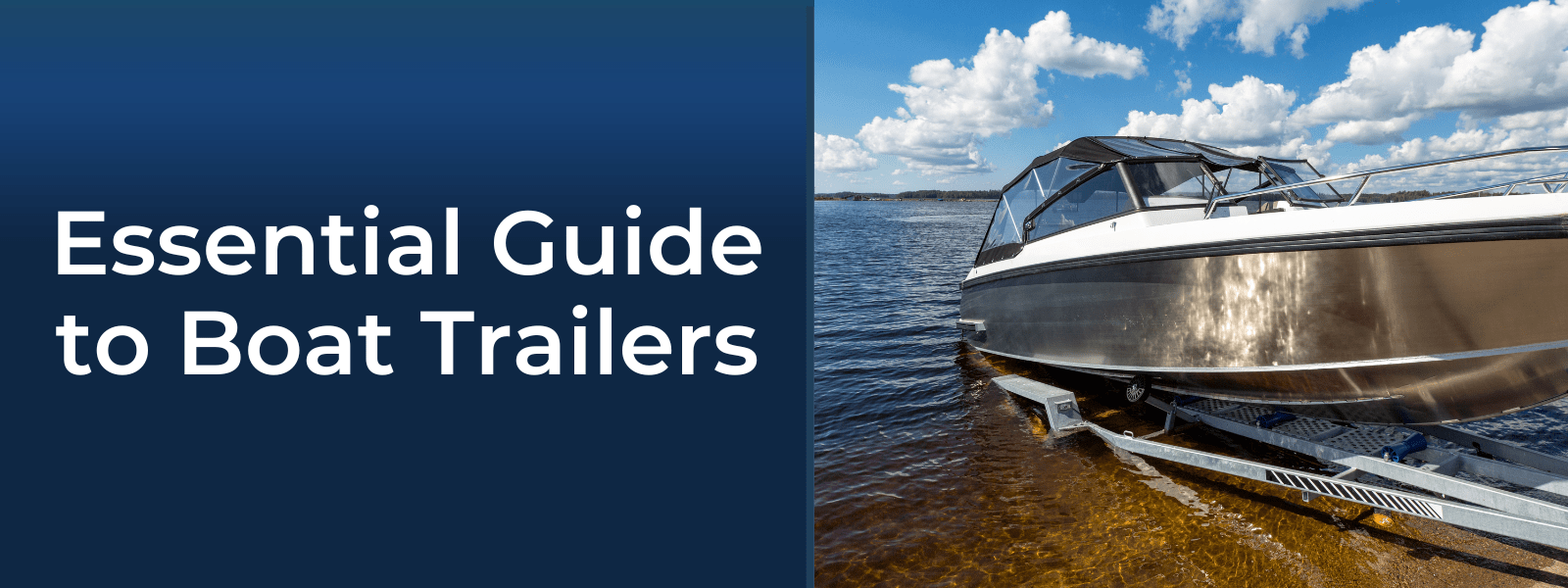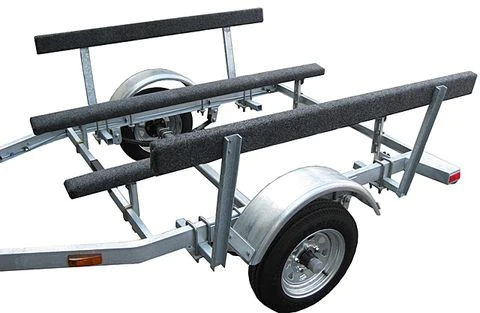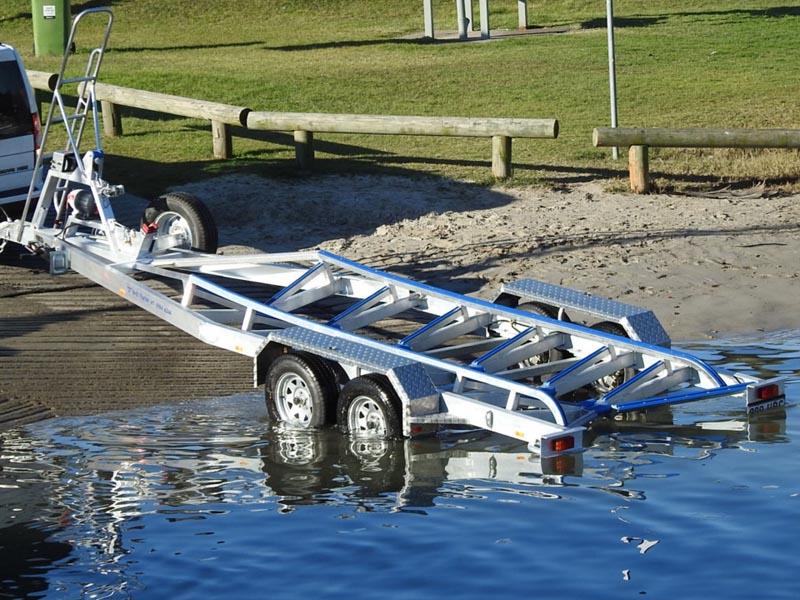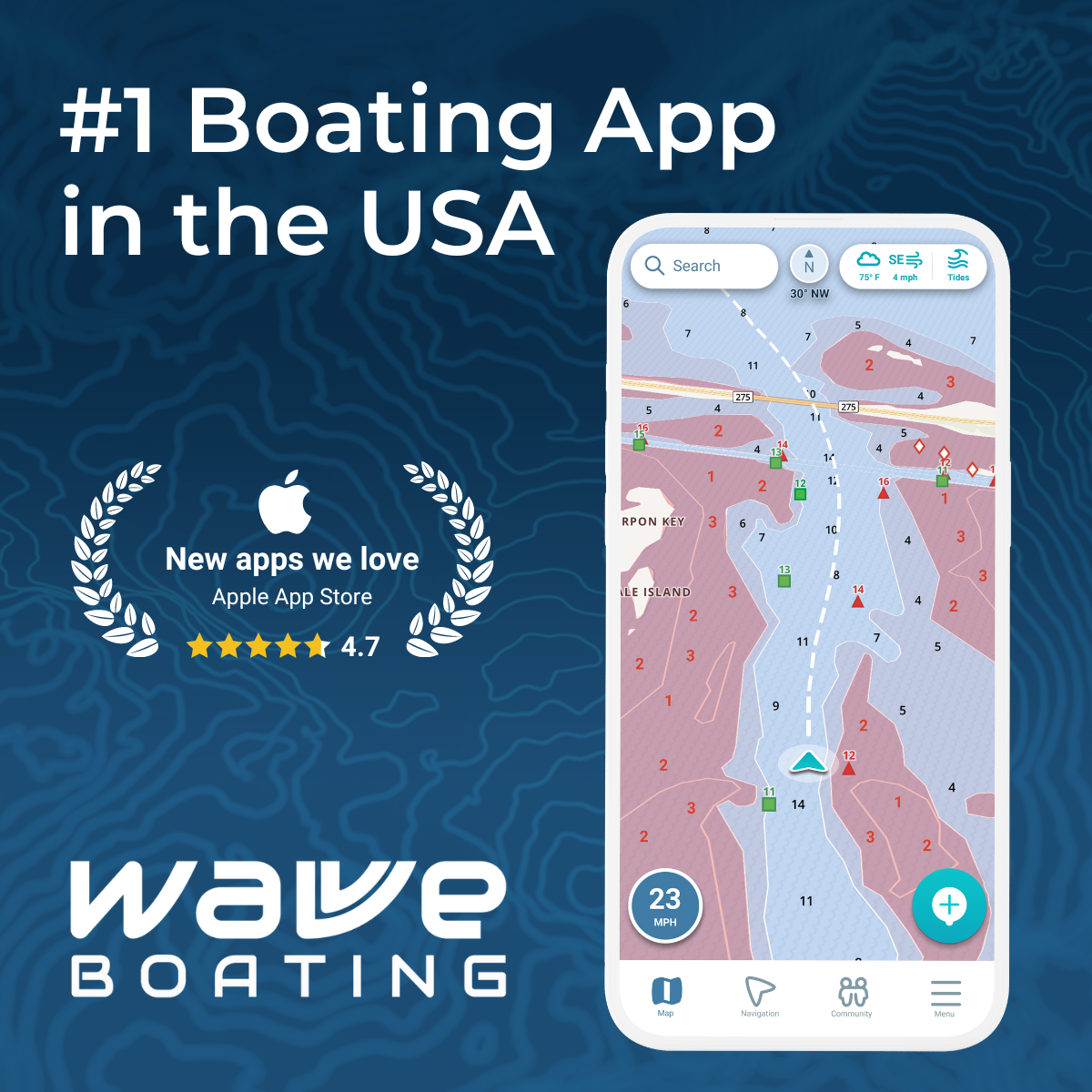
Essential Guide to Boat Trailers
When you shop for a boat, you can face a dizzying array of options – ranging from engines and propellers to underwater lighting and audio systems. All are important decisions, especially anything related to horsepower. (Argh, argh, argh.) But it’s easy to overlook one mission-critical accessory: the boat trailer.
Even though a particular trailer might be bundled with a boat at the dealership, that trailer might not match your needs. Instead, you want to consider a handful of factors when selecting a trailer to make sure it suits your boating lifestyle and your budget.
Having the right trailer helps you get the most enjoyment from your watercraft. It gives you the freedom to tow your boat to more waterways around the country. The right trailer can also make it easier to launch your boat, avoiding some stress at the ramp and increasing your on-the-water time.
Plus, a trailer gives you more options for boat service, repairs and storage beyond the local marina. And a quality trailer will help protect your investment whenever your boat is being hauled or stored.
Understanding trailer types, materials, options and accessories might seem overwhelming. That’s why we put together an essential list. Keep reading for a complete guide to choosing the correct trailer for your boat.
Metal Matters: Note the Difference Between Aluminum and Steel Boat Trailers
Modern boat trailers are typically made from galvanized steel, painted steel, or aluminum. Choosing between a steel or aluminum trailer comes down to budget, towing weight and the kind of water you typically boat in (freshwater or salt).

Steel Boat Trailers are Suited for Freshwater
If you boat in freshwater, a steel trailer might be ideal for you. Available in painted and galvanized steel, they offer greater stability than aluminum trailers. Painted steel models are also good entry-level options because they’re both affordable and durable.
The major drawback to steel is corrosion. Over time, saltwater and road salt can affect the trailer’s integrity. Galvanized steel trailers are coated with liquid zinc to keep corrosion at bay. This gives you the flexibility to boat in both freshwater and saltwater settings without corrosion worries. On the other hand, no matter how frequently you rinse a galvanized trailer, the zinc coating will eventually wear off. And that exposes the steel to corrosion.
Higher cost is another downside to galvanized steel trailers. Plus, their heavier weight increases fuel consumption when towing the boat.
Aluminum Boat Trailers are Ideal for Saltwater
Aluminum trailers are corrosion resistant, making them ideal for saltwater boating. They’re also lightweight for easier maneuverability and better fuel efficiency.
One tradeoff with aluminum trailers is they aren’t as strong as steel models. Aluminum trailers are also more expensive than steel trailers.
NOTE: Before you select a boat trailer, consider how the frame materials affect towing capacity. You will want to make sure your vehicle is able to accommodate the combined boat and trailer weights.
Choose a Trailer Style to Suit Your Access and Budget Needs
The two common trailer types are bunk – or float-on – and roller models. And they suit different budgets and access conditions..

Bunk Style Trailers are Straightforward and Less Expensive
Bunk trailers have a simple design with no moving parts. The boat hull rests on a padded – often carpeted – set of bunks. And they’re perfect for everything from personal watercraft (PWCs) to pontoons. Some bunks are even configured to carry two PWCs.
Since they’re typically smaller with fewer moving parts, the bunk design is the least expensive trailer option.
The key factor is that bunk trailers need to be submerged for the boat to float into the water. Otherwise, launching/re-loading can be challenging on shallow boat ramps or in low-tide conditions because of friction between the hull and the bunks.
With some muscle, PWCs and some lighter boats can be launched in shallow water from bunk trailers. But large, heavier boats will need access to a long, deep-water boat ramp.
Then again, if you plan to keep your boat at a marina – either moored or in a dry storage stack – you might not use the trailer frequently. Or you may have access to a hoist. So, a simpler design like a bunk trailer may fit your boating and storage pattern.
Roller Trailers Offer Greater Launch Flexibility
If you plan to launch your boat frequently, consider a roller trailer. They don’t require deep submersion to launch because they’re equipped with multiple rollers. And that efficient design works with gravity to make launching and re-loading easier in all conditions, including short boat ramps and even straight from the bank.
Plus, less submersion means reduced wear-and-tear on the trailer components, including brakes, axles, lights and wiring.
One tradeoff for this convenience is price. Roller trailers cost more because of the additional moving parts. And you might want to invest in a better winch to help secure your watercraft on the trailer. But the upside to a roller trailer is the freedom to launch and use the boat in more locations.
In a hybrid approach, some boaters add rollers to their bunk trailers. It’s less expensive than a roller trailer. And boaters gain added launch flexibility over a traditional bunk model.
PRO TIP: A marine navigation app can help you avoid challenging launch conditions. The Wavve Boating App, for instance, monitors water depth and tide patterns at boat ramps. So, you can confirm the water is deep enough before heading to the ramp. And, if needed, the Wavve app can help you find an alternative launch location. Scroll down for more information on Wavve Boating or click here to download the app now.

Select Trailer Options to Improve Hauling and Handling
When you select a trailer, axle and brake options can affect handling and maneuverability. Read on for some helpful suggestions.
Brakes Protect Your Boat Investment
Depending on the size of your watercraft, your trailer might need brakes. PWCs and smaller boats – like aluminum skiffs – are light enough to haul without brakes. On the other hand, medium and larger boats will definitely need brakes to provide added stopping capacity and greater peace of mind. The last thing you want to do is overpower your towing vehicle and risk damaging your boat or someone else’s vehicle.
Most states require trailer brakes for mid-sized boats and larger. To confirm whether your boat trailer needs brakes, ask your boat dealer or check here.
The most common types of trailer brakes are surge and electric. Surge brakes are activated by momentum from the towing vehicle. And some boaters favor surge brakes because their simpler, non-electric design withstands being submerged better than wiring and components. They’re also an inexpensive alternative to electric brakes.
But one big tradeoff is handling. When they’re applied, surge brakes can cause the trailer to jerk and buck, making the ride rougher.
On the other hand, electric trailer brakes offer faster responsiveness and better stopping power. They also provide a smoother ride when hauling a boat at high speeds.
Water and corrosion damage are a drawback to electric brakes. And higher cost versus surge brakes can be a factor.
Keep in mind, if you are feeling budget constraints, trailer brakes can be upgraded later when your budget allows.
Axles Affect Trailer Handling and Maneuvering
You may have noticed some boat trailers have two wheels and others have four. Boat size and budget can help you choose between those single- and dual-axle (tandem) trailer configurations.
Single-axle trailers are ideal for watercraft that are up to 22 feet (6.7 meters) long. They are lightweight and easy to maneuver in tight spots. Plus, they’re easier on fuel consumption. And fewer tires, axles and brake components mean single-axle trailers cost less.
The tradeoffs for single-axle models are capacity and handling. They obviously cannot accommodate larger boats. And single axles don’t handle as smoothly on the highway, particularly when traveling at high speeds.
Tandem or dual-axle trailers, on the other hand, are perfect for larger watercraft. Two axles split the load more evenly, which provides greater stability on the highway. Plus, the extra axle means another set of brakes for more stopping power.
For some added peace of mind, if your tandem-axle trailer gets a flat tire, you can typically continue driving with the other three tires until reaching your destination.
Price and fuel efficiency are the biggest drawbacks for dual-axle trailers. Maneuverability in tight spaces can also be a challenge. And more axles, tires and brakes translate into higher maintenance costs.

Size Things Up: Confirm the Boat Weight and Your Towing Capacity
When it comes to trailering boats, the tail often wags the dog. In other words, the boat and trailer might dictate what type of towing vehicle you use.
An important step in buying a boat trailer is to make sure your watercraft fits the trailer. Plus, you want to confirm your vehicle has adequate towing capacity for both.
Check Boat Weight and Measurements
To make sure your boat fits the trailer, confirm the vessel dimensions and weight. You can find the boat figures in the owner’s manual. If that’s not available, check used boat portals. Note: Some manufacturers only furnish the “dry weight” or hull weight. So, you may need to add weight for the engine(s) and fuel.
Verify Your Boat Trailer Capacity
Most trailers offer a generous amount of capacity – found in the gross vehicle weight rating (GVWR). But you want to make sure your boat and gear aren’t overtaxing the trailer.
Check the VIN plate mounted on the trailer frame. In addition to the GVWR, the VIN plate includes the serial number (VIN), trailer model and manufacturing date.
The total boat and trailer weight cannot exceed the GVWR figure on the VIN plate. For an estimate, start with 600-to-900 pounds (275 to 400 kg) for the trailer weight. Next, add the boat’s dry weight from above, and incorporate an estimated figure for fuel, coolers, ice, and gear. That total figure cannot exceed the trailer’s GVWR.
To sense-check your math, ask the boat dealer to confirm the GVWR for the fully loaded trailer. If you prefer to buy from a private seller, or operate with a “trust but verify” mindset, ask the seller to tow the trailer to a truck scale and pay to have it weighed.
Confirm the Towing Capacity for Your Vehicle
Armed with the GVWR for your fully loaded boat trailer, it’s the moment of truth. Does your vehicle have enough towing capacity to safely haul your boat and trailer?
Find the Gross Combined Vehicle Weight (GCVW) for your towing vehicle. If you can’t locate the GCVW in the owner’s manual, here’s a good online resource.
Now that you know how much your fully loaded boat trailer weighs (the GVWR), add that figure to the gross weight for your tow vehicle. Plus, incorporate the weight of your passengers and any gear that’s in the vehicle. And compare that total figure to the GCVW for your towing vehicle.
Note: A good rule of thumb is for the combined weight (of the vehicle, passengers, cargo and loaded boat trailer) to be roughly 80% of the GCVW. If the overall total weight is close to the GCVW, you may want to use a different towing vehicle for safety.
Another way to improve your towing capacity is to send passengers and their boating gear – including coolers and ice – in a separate vehicle.
Accessorize Your Boat Trailer
Boat trailer accessories offer a practical way to improve hauling and launching. Plus, add-ons can express your personality.
Some popular ways to accessorize your boat trailer include:
- Plastic bunk covers for easier unloading/loading
- Load guides to help align the boat as it’s being loaded
- Folding tongue to fit your trailer into garages and other tight spots
- Tongue jack to raise and lower the trailer and support it during storage
- Fender protectors to step on/off the trailer
- Spare tire
- LED light kits
- Custom rims
Apply Your Trailer IQ to Find the Right Model for Your Boating Needs
A boat trailer is a key accessory. The right trailer choice can protect your boat investment. Plus, choosing the right model for where-and-how you access the water will help enhance your overall boating experience. After reading this article, you’re all set for boat shopping. Your improved trailer IQ will help you communicate and negotiate with boat salespeople.
Ready to hit the water?
If you’re interested in hitting the water, but aren’t sure exactly where to go (or how to get there) check out the Wavve Boating App. You can review the top rated destination near you and easily connect with your friends out on the water. It’s an all-in-one tool that’s sure to have everything you need…no matter which boating adventure you’re on.
Wavve Boating is available on the Apple App Store and Google Play Store. To discover more, visit us in the app.









